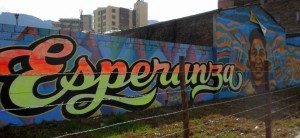reflections on colombia 3 – stories of resilience

If the first word (displacement) represents the cause of the suffering and the second word (accompaniment) represents the path of those, Colombian or ex-pats, who seek to care and help, the third word represents the hope in the heart of the victims, and that word is resilience.
I will tell three stories that represent resilience. The first took place in the pre-school we visited in 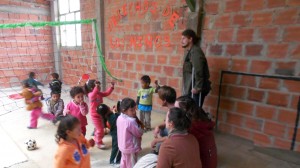 the heart of the slums of Cazuca, Soacha. Run by a Mennonite Brethren church planted there, this project was motivated by the countless children abandoned for most of the day by parents travelling hours away to work to survive. One day, church members heard children crying and screaming from inside a locked tin shack of about six square metres. They broke the lock and found four young children (locked in by their parents for their protection), one of whom appeared lifeless after drinking kerosene that had been stored in an empty pop bottle. They rushed to the hospital while praying desperately. Miraculously, he survived with no ill effects, but the church became committed to starting a pre-school. What we saw were dozens of children cared for by trained local teachers (the pedagogy and values would rival any pre-school here at home). In spite of horrid living conditions and frequent abuse at home or on the street, these children were unbelievably happy and energetic. If you would want to help make this specific work possible, you can support this specific project through MCC’s Global Family program.
the heart of the slums of Cazuca, Soacha. Run by a Mennonite Brethren church planted there, this project was motivated by the countless children abandoned for most of the day by parents travelling hours away to work to survive. One day, church members heard children crying and screaming from inside a locked tin shack of about six square metres. They broke the lock and found four young children (locked in by their parents for their protection), one of whom appeared lifeless after drinking kerosene that had been stored in an empty pop bottle. They rushed to the hospital while praying desperately. Miraculously, he survived with no ill effects, but the church became committed to starting a pre-school. What we saw were dozens of children cared for by trained local teachers (the pedagogy and values would rival any pre-school here at home). In spite of horrid living conditions and frequent abuse at home or on the street, these children were unbelievably happy and energetic. If you would want to help make this specific work possible, you can support this specific project through MCC’s Global Family program.
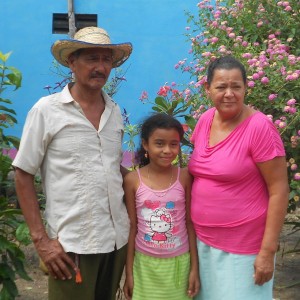 My second story is about Narciso, a campesino (small farmer) who takes care of the model farm for Sembrandopaz (a community advocacy and peace organization, sponsored in part by MCC). As a leader among farmers, he was targeted by the paramilitary who suddenly appeared at his door one evening and shot him in the lower part of his face. The people of his village were paralyzed by fear and wouldn’t help, and for two hours all they could do was to cry out in desperate prayer. Finally, they were able to travel to get help – passed from unequipped clinic to clinic, they managed to let it appear (for the sake of the paramilitary) that he was dead and eventually reached a city hospital where they operated on him. He and his wife hid out with his daughter in a different city where his body recovered but his soul languished. What could a farmer do away from his land?
My second story is about Narciso, a campesino (small farmer) who takes care of the model farm for Sembrandopaz (a community advocacy and peace organization, sponsored in part by MCC). As a leader among farmers, he was targeted by the paramilitary who suddenly appeared at his door one evening and shot him in the lower part of his face. The people of his village were paralyzed by fear and wouldn’t help, and for two hours all they could do was to cry out in desperate prayer. Finally, they were able to travel to get help – passed from unequipped clinic to clinic, they managed to let it appear (for the sake of the paramilitary) that he was dead and eventually reached a city hospital where they operated on him. He and his wife hid out with his daughter in a different city where his body recovered but his soul languished. What could a farmer do away from his land?
Eventually, a welcome and initial support from a local church restored some of his spirit, but he still had nothing productive to do. Then some people from Sembrandopaz offered him the chance to care for their model farm – the farm on which our group was accommodated in a new simple and beautiful cabaňa (in bunks and hammocks). Here he has begun to transform the overgrazed and neglected land into a sustainable and integrated farm. Every meal we tasted a different fruit juice grown there.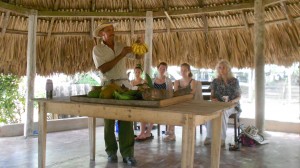
But for all the pathos in Narciso’s tale of violence and recovery, the most touching part was when he expressed the pain that he shares with most of the country’s campesinos. These people who for generations have been the bond to the land, growing the food that sustains everyone, have been neglected and mistreated. As innocents trapped between the power struggles of others, they have had few effective voices raised up on their behalf. And even as he was overwhelmed with gratitude and loyalty to Sembrandopaz for the opportunity they gave him, we could feel the pang in his heart that the land he nurtured was not his own and could not be passed on to his children and grandchildren.
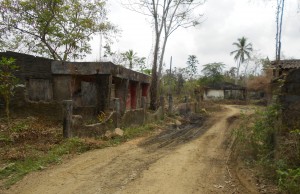
The third story was told by the villagers of Mampujan, one of the villages supported by Sembrandopaz. In the year 2000, a paramilitary group came to terrorize them and massacre a handful of their leaders (their typical strategy at that time). A passionately evangelical village, they turned their terror into prayer and were comforted when a few of them saw white lights above the hills – believed to be angels watching over them. Soon a phone call led the leader of the armed men to choose not to kill anyone, though they still ordered everyone to leave their village and stole all that was of value.
Not very far away, the group was able to stay together, eventually building a crowded shantytown close enough that they could still come to their land by day to grow food. A missionary taught the bored and traumatized women to quilt, and the women transformed this skill into making tapestries that told the story of their village and soon the stories of their Afro-Colombian roots. 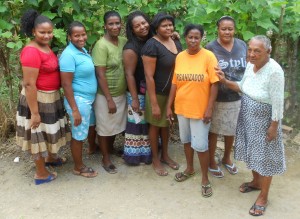
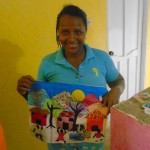 Now a co-op of women sew tapestries to earn an income and several of us took one home. These tapestries no longer depict the season of violence and terror, but envision their return to a peaceful and productive village life.
Now a co-op of women sew tapestries to earn an income and several of us took one home. These tapestries no longer depict the season of violence and terror, but envision their return to a peaceful and productive village life.
In these and many other stories of new hope, three common themes seemed to be at the root of their resilience. The first was their relationship with the land. While those who have ended up in the outskirts of Bogota are most cut off from this vital resource, the more they were able to maintain some connection with land and place, the more they were able to maintain a healthy and meaningful life.
The second source of resilience was the strength of their communal relationships. In some cases these were strong enough to remain intact in spite of the displacement and violence. At other times, people were able to form new communal ties, often supported by care from a variety of organizations. Within these relationships traumatic memories are shared and healed. Plans are formed together and voices raised collectively.
The third source of resilience was the faith and culture of the people. So often people emphasized the role that prayer played in their survival. Where tragedy happened, people grappled with why some were protected and some weren’t. Seasons of lament were transformed into new seasons of celebration. The possibility of forgiveness frees people from bitterness and becomes the foundation for dreams of reconciliation. Yet most people were quite honest and realistic in stating that the full season of reconciliation is not yet here. They prepare and hope that it is just around the corner.
